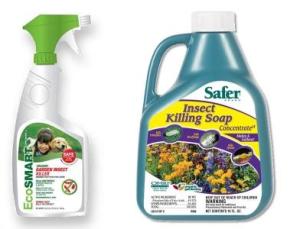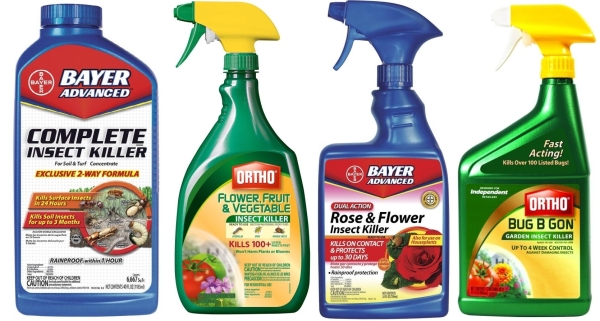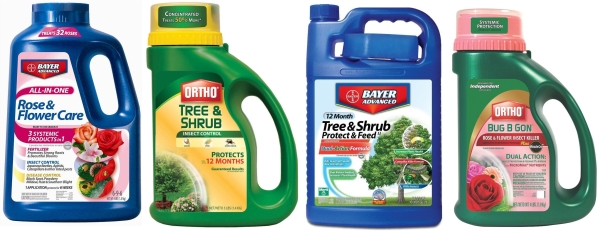I’m getting rid of Imidacloprid – Avoiding the Worst Neonicotinoid Insecticides
I’m often asked which products are OK and which should be avoided. Hence the mnemonic in the title to help you remember I’m getting rid of Imidacloprid. Say it three times out loud, and when you read the labels at the garden store you will remember: I’m getting rid of Imidacloprid.
When it comes to insecticides, first ask yourself , do you really need them? Rather than automatically reaching for a spray bottle, first take a close look at your foe. Do you know what it is, its life cycle? What will happen if you do nothing? Are there any natural predators around? Open your eyes to the fascinating world of insects and their daily dramas before killing them all.
Attentive gardeners are always on the lookout for the pests they have come to know. I expect cabbage caterpillars to appear as soon as I see the pretty white butterflies flitting about. So I watch the plants for any sign of the worms and many times I notice predatory wasps patrolling with me. I don’t get all of the worms by hand picking; there are always some left for the wasps. Between us, we don’t need anything else to keep the worms off the broccoli. Hand picking works for many garden pests.
Healthy plants are more resistant to insect pest. Good growing conditions, water and organic fertilizer are your first choices to solve problems. A good resource when you have problem is NCAP’s solution tool box. Occasionally you may be driven to need something more. So lets look at the good, the bad, and the ugly, when it comes to garden chemicals.
The Good: Soaps and Oils
 The least toxic chemicals are often soap or fat/oil based emulsions that disrupt the pest with little environmental impact. Safer Brand and EcoSmart products are generally a good choice for chemical products that have low toxicity and are usually derived from organic ingredients. The major pesticide brands like Ortho and Bayer also have lines of less toxic chemicals but I would suggest patronizing brands that generally avoid the worst chemicals in all of their products. Read the labels!
The least toxic chemicals are often soap or fat/oil based emulsions that disrupt the pest with little environmental impact. Safer Brand and EcoSmart products are generally a good choice for chemical products that have low toxicity and are usually derived from organic ingredients. The major pesticide brands like Ortho and Bayer also have lines of less toxic chemicals but I would suggest patronizing brands that generally avoid the worst chemicals in all of their products. Read the labels!
The Bad: Neonicotinoid Pesticides
There are plenty of bad chemicals. I’m mostly concerned about the insidious, highly toxic neonicotinoid insecticides because they are long-lasting in the environment and sub-lethal amounts of toxin will accumulate and cause harm in bees and other beneficial insects. The list of products that contain neonicotinoid insecticides is a long one. Common on this list are foliar sprays for direct control of insect pests. 
Ortho brand sprays usually contain acetamiprid, a neonicotinoid that is less toxic and more quickly degrades than imidacloprid. Bayer foliar sprays contain imidacloprid. The extended length of time the chemicals continue to kill insects can clue you in on how much active ingredient is being spread about and their relative environmental impact. The Bayer Complete Insect Killer has a lot of active ingredient and really belongs with the ugly product below.
The Ugly: Mindless-Use, Soil-Contaminating, Neonicotinoid Pesticides
These are the real problems. Insecticides that are applied in the soil need to have more active ingredient in order that enough is taken up by the plant to be effective. This means that much more is still left in the soil where it can contaminate non-target plants for many years and eventually move into the ground water.
Tree and shrub product use large amounts of chemical. Many flowering shrubs are prime bee forage, make an attractive and deadly combination. The soil around treated trees will grow toxic flowers for years. The “all-in-one” and “protect & feed” products contain fertilizer as well as imidacloprid. This leads to mindless needless insecticide use and soil contamination. The Bayer All-in-One Rose and Flower Care also contains clothianidin, another deadly neonicotinoid, in addition to imidacloprid. Please do not use these chemicals, for the sake of the bees and the entire invertebrate eco-system.
Remember, I’m getting rid of imidacloprid!

Gary, you are doing a great job on behalf of bees. The other brand that is deadly to bees is Scotts of Ohio’s ROSE CLEAR and BUG CLEAR. If you send me an email I will send you some good JPEGS of the products involved.
Gary – that’s a great piece! You are absolutely right when you say :
“Do you know what it is, its life cycle? What will happen if you do nothing? Are there any natural predators around? Open your eyes to the fascinating world of insects and their daily dramas before killing them all”.
Also, know what ‘damage’ they will actually do to the crop and plant, and assess whether it really matters, because often, it doesn’t!
2 examples:
Last year, caterpillars ate the leaves of my (newly purchased) red currant bush. I knew the caterpillars would be around – I’d seen the cabbage whites, However, they didn’t touch the fruit – just the leaves. I picked off quite a few of the caterpillars and put them on the bird table, but to no avail, I literally had loads of them. Eventually, I left them to it, and they stripped the leaves completely. This year, the bush is growing new leaves and looks healthy as ever. If the caterpillars come back, so what? I have decided to leave them to it. They eat the leaves, I eat the fruit, the next year I see butterflies, which in turn can be eaten by bats and birds. Everyone wins. Does it matter to me that the leaves get stripped? No, why should it be a big deal? It’s only for part of the latter part of the season, and the leaves would have dropped for winter anyway.
Also, brocolli, as you mention. My sister grows it too, and one year, she tried an experiment. She decided to leave the caterpillars to their munching to see what would happen. All that happened was the caterpillars nibbled the stalks a little and left the heads alone. Big deal – she trims the stalks anyway! It wasn’t ‘supermarket’ pristine, but it had no chemicals on it. Now she doesn’t even bother to pick the caterpillars off!
I also wrote a blog you might like: most insects are beneficial or harmless – I think this is a message worth getting out there:
http://www.buzzaboutbees.net/beneficial-insects.html
I agree with you totally. Plants also figure this stuff out themselves. The second set of leaves that plants sometimes grow are much less palatable to the insects. The best “insecticide” for broccoli is a healthy plant. Fertilize well, and the plant will not have aphids – don’t fertilize and it will – at least around here…
How would you propose to keep a Little Leaf Linden tree from dieing of Japanese Beetle infestation? I had literally my whole tree infested with them last summer, and apparently if this happens three years in a row, I lose the tree. I’m concerned about the bees, and other living creatures….I need a Successful alternative!
Hello Annis,
Here is Organic Gardening info on controlling Japanese Beetles:
http://www.organicgardening.com/learn-and-grow/japanese-beetles.
Good luck and thanks for caring about our bees and native pollinators!
Hi Annis, Please don’t use imidacloprid on your linden. From Wikipedia: “The small yellow-green hermaphrodite flowers are produced in clusters of five to eleven in early summer with a leafy yellow-green subtending bract, have a rich, heavy scent; the trees are much visited by bees.”
But your frustration illustrates why this is such a problem. Tree injections and heavy soil treatments for trees generate the highest contamination levels of imidacloprid residues – much greater than typical crop application residue levels. The poison will be there year after year when the tree is in bloom. Besides nectar and pollen when in bloom, lindens and poplars are used by the bees as a source of propolis.
So what to do? Good question. I’d be curious to hear what ideas and suggestions you come up with. Please keep us posted.
I am a caregiver in a Medical Marijuanna state, and grow indoors. I have avoided all non organic methods but thrips have been whooping my butt! Ladybugs, nematodes, neem, hydrogen peroxide, 125 degree water… all failed . Then I found acetamiprid ! Knocked those little bastards out!! Gone. Done. No more,show over! But I am aware of CCD , and know something must be done. But do nothing or depend on those other methods is not an option.. they don’t work! It’s results I’m after. Tell me of something that is safer, AND works just as good and I’m on it!
Thanks-Justin Hale, Michigan
Hi Justin, Greenhouses have their own set of problematic pests and it looks like you found one of them. The further you are from a complex ecosystem, the more likely you will have pests. I can’t tell you the answer; you know your business better than I do, but don’t stop looking for alternatives. Fortunately, whatever you do is not likely to cause more problems for bees because they can’t get to your plants. And if you have to choose a neonic, acetamiprid is less problematic than some of the others.
Thanks for the reply. I do not and will not use outside.
What should we use when our ash trees are infected with the emerald ash borer insect? What can we do if some trees are not infected yet?
Thank you, appreciate your help.
Hi Ralph, I’m not an expert on all possible treatment methods for all insect problems, but I’ll give this a try. First, gradaully replace suseptible trees with trees that are less likey to suffer insect problems. The emerald ash borer is a relatively recent invasive species, so it will be working its way through our trees for years to come until a natural balance eventually works itself out. In the mean time it is tempting to treat trees with insecticieds to keep them alive. A quick google search turned up the following:
Click to access eab_fact_sheet_2012_cowles_locked.pdf
The take-home point is that ash trees bloom in early spring and a pollen forage source for bees. Treatment of ash trees should be timed for just after the bloom and with insecticides that have a low residual by the time of the next bloom. That rules out imidacloprid, one of the favorite tree injection or soil treatment options. Imidacloprid is known to remain at toxic levels for several years in trees, so will be present in pollen more than a year after application. The article linked above suggests that dinotefuran, also a neonic, has less residual activity.
Become informed yourself about treatment options, and then discuss this with local arborists and tree experts in your area. Be prepared to make the point that imidacloprid, although being easily available and popular is NOT the way you want to go. Many tree care experts are not as well informed on these issues as you will be once you take the time to research this issue. If you discover something better, please let us know here.
Great post!
Any suggestions for an organic alternative to imidacloprid for citrus leaf miners? We have issues with them in Southern California. I have a young lemon tree & they are attacking more leaves & new growth than I’d like to see.
Maybe I should find some natural predators to introduce…
Hi Rita,
Here is the best advise I could find:
http://homeguides.sfgate.com/organic-pesticides-citrus-leaf-miners-38056.html
It mentions some natural predators.
http://ipm.ifas.ufl.edu/Agricultural_IPM/clmhoy8.shtml
Good luck!
Gary